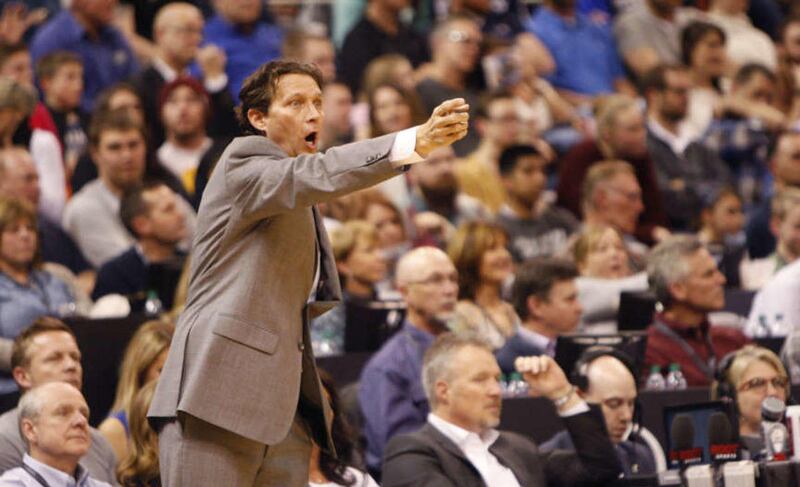Let’s not just throw the data in a computer. Let’s interpret it. The people that are collecting and applying the data, they’re not just collecting raw data. They’re manipulating the data to help us interpret it, which I think is the main thing. – Jazz coach Quin Snyder
DENVER — Charles Barkley opened his mouth — not an unusual thing — and about sent stat geeks into a tizzy a couple of weeks ago.
During a TNT-televised rant about Houston general manager Daryl Morey, Barkley responded to an insult by the executive with some heated comments.
“He’s one of those idiots who believes in analytics,” Barkley said. “I’ve always believed that analytics is crap.”
Lakers coach Byron Scott reignited the conversation before Wednesday’s game when he told reporters in his pregame interview that he’s not a believer.
"I think we’ve got a few guys who believe in it,” he said, according to the Orange County Register. “I’m not one of them."
The coach on the other side of the court is.
Quin Snyder doesn’t base all — or even most — of his game-planning decisions and strategy on the oodles of statistical data at his fingertips.
But the Jazz coach is a believer. He routinely seeks out information and trends from Utah general manager Dennis Lindsey and his analytics crew (including Bart Taylor and Taylor Snarr) to see if there are tactical adjustments that can be made based on numbers.
Snyder, who obviously relies on knowledge of his three assistants and player development staff, described his working situation as a “partnership” with Lindsey et al.
The tough part on occasion can be taking that raw data and manipulating it into a way that can be useful on the court as well as on paper.
Snyder listed three areas in which he uses analytics and advanced stats (more detailed than just the usual points/assists/rebounds per game).
• Lineup combinations.
This helps the Jazz determine how to react with matchups when an opponent plays small or uses a shooting big. Any extra advantage in countering your foe gives you an added bonus.
• Pick-and-roll coverages.
By knowing your opponents’ shooting percentages from different spots on the floor (the right elbow, top of the key, etc.), you’re able to determine whether to go over screens, under them, back of and let a player shoot and so forth. It’s always a gamble, but the Jazz would rather be the guys who can count cards at the blackjack table than ones who simply play for fun.
“You’re playing a percentage,” Snyder said.
• An opponents’ effective field goal percentage (factors in 3-pointers’ extra value).
This, Snyder said, is one of his main criteria in judging how well his team is playing defense. Utah, whose "D" has improved this season, is currently ranked 22nd in the NBA, allowing opponents to notch a 50.2 effective field-goal percentage.
“Obviously, your effective field-goal percentage is really, really important. That’s essentially more than any other factor that’s going to determine why teams are doing well,” Snyder said. “You can’t just hope that field-goal percentage goes down.
You’ve got to do what you can to disrupt them and make them miss — contest shots, deflections, ball pressure.”
All of these analytics and advanced stats are not an exact science, of course. Players’ and teams’ stats can be much different in recent games than over the course of the season or in their career.
“Let’s not just throw the data in a computer. Let’s interpret it,” Snyder said. “The people that are collecting and applying the data, they’re not just collecting raw data. They’re manipulating the data to help us interpret it, which I think is the main thing.”
NBA experts, for instance, will point out that corner threes give you more bang for the buck than almost all other shots.
By that same measure, long twos, especially those with toes dragging across the 3-point line, are the least effective attempts.
Mid-range jumpers?
Might as well move back behind the line.
Transition attempts and shots within the restricted zone (the half circle area) are preferred by analytical types, too.
“If you don’t have it, you don’t get a chance to look at it,” Snyder said. “I think sometimes your conclusions are going to be erroneous, but more often than not it’s information that’s useful. I’d much rather have it. I believe in it.”
The keys to making it effective are open dialogue and balance.
“If you chose to ignore it,” he said, “I think that would be a mistake.”
Sorry, Charles.
Not that that will change Barkley’s opinion on analytics.
“It’s just some crap that some people who are really smart made up to try to get into the game because they had no talent … to play the game,” Barkley continued. “Smart guys wanted to fit in so they made up a term named ‘analytics.’ ”
The Round Mound said talent trumps stats.
“The NBA is about talent. All these guys who run these organizations who talk about analytics, they have one thing in common: They’re a bunch of guys who ain’t never played the game and they never got the girls in high school and they just want to get into the game.”
EMAIL: jody@desnews.com
TWITTER: DJJazzyJody


